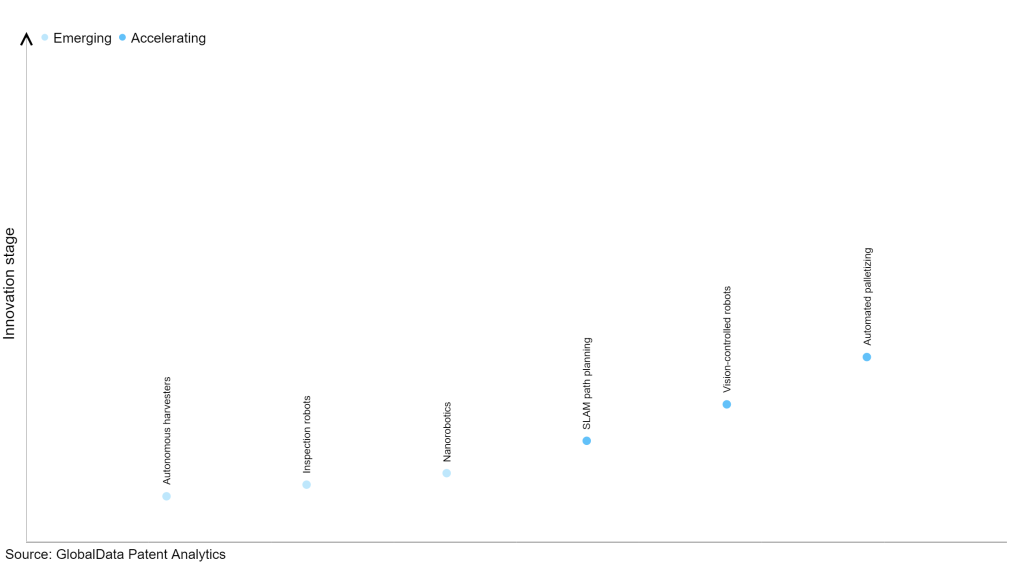The technology industry continues to be a hotbed of patent innovation. Activity is driven by the need for increased efficiency, accuracy, and cost reduction in warehouse operations, as well as the rising demand for e-commerce and rapid order fulfilment. Also, growing importance of technologies such as autonomous mobile robots, warehouse management systems, and machine learning algorithms for predictive analytics is driving the market. In the last three years alone, there have been over 1.5 million patents filed and granted in the technology industry, according to GlobalData’s report on Robotics in technology: warehouse management automation. Buy the report here.

Access deeper industry intelligence
Experience unmatched clarity with a single platform that combines unique data, AI, and human expertise.
However, not all innovations are equal and nor do they follow a constant upward trend. Instead, their evolution takes the form of an S-shaped curve that reflects their typical lifecycle from early emergence to accelerating adoption, before finally stabilizing and reaching maturity.
Identifying where a particular innovation is on this journey, especially those that are in the emerging and accelerating stages, is essential for understanding their current level of adoption and the likely future trajectory and impact they will have.
185+ innovations will shape the technology industry
According to GlobalData’s Technology Foresights, which plots the S-curve for the technology industry using innovation intensity models built on over 1.6 million patents, there are 185+ innovation areas that will shape the future of the industry.
Within the emerging innovation stage, autonomous harvesters, inspection robots and nanorobotics are disruptive technologies that are in the early stages of application and should be tracked closely. SLAM path planning, vision-controlled robots, and automated palletizing are some of the accelerating innovation areas, where adoption has been steadily increasing.
Innovation S-curve for robotics in the technology industry

Warehouse management automation is a key innovation area in robotics
Warehouse management automation is the use of technology to automate or streamline the day-to-day operations of a warehouse. This includes processes such as inventory control, order fulfilment, shipping, and receiving. Automation can help improve efficiency, accuracy, and cost savings throughout the warehouse.
GlobalData’s analysis also uncovers the companies at the forefront of each innovation area and assesses the potential reach and impact of their patenting activity across different applications and geographies. According to GlobalData, there are 240+ companies, spanning technology vendors, established technology companies, and up-and-coming start-ups engaged in the development and application of warehouse management automation.
Key players in warehouse management automation – a disruptive innovation in the technology industry
‘Application diversity’ measures the number of applications identified for each patent. It broadly splits companies into either ‘niche’ or ‘diversified’ innovators.
‘Geographic reach’ refers to the number of countries each patent is registered in. It reflects the breadth of geographic application intended, ranging from ‘global’ to ‘local’.
Intel is one of the leading patent filer in the warehouse management automation. One of the company’s patents describes a computing device for speculatively decompressing data. The device includes a deterministic decoder, one or more speculative decoders, and a decompression manager. The decompression manager determines the size of the smallest variable size code in the compressed data, decodes a variable size code using the deterministic decoder, and concurrently performs speculative decodes using the speculative decoders. The device outputs the first symbol associated with the deterministically decoded code and the second symbol associated with the speculatively decoded code.
Other prominent patent filers in the space include Ocado Group and Amazon.com.
By geographic reach, Intel leads the pack, followed by OPEX and Crown Equipment. In terms of application diversity, Ocado Group holds the top position, followed by SoftBank Group and Amazon.com.
Warehouse management automation involves the use of technologies such as robotics, artificial intelligence, and data analytics to automate tasks like inventory management, order picking, and packing. Other key technologies involved include autonomous mobile robots, warehouse management systems, and machine learning algorithms for predictive analytics.
To further understand how robotics is disrupting the technology industry, access GlobalData’s latest thematic research report on Robotics.
Data Insights
From

The gold standard of business intelligence.
Blending expert knowledge with cutting-edge technology, GlobalData’s unrivalled proprietary data will enable you to decode what’s happening in your market. You can make better informed decisions and gain a future-proof advantage over your competitors.







